You might not know Dead Horse Ranch State Park protects 423 acres of riparian habitat along the Verde River, a rare island of cottonwoods and willows in central Arizona. You’ll find well-marked trails, excellent trout fishing, and quiet campsites tucked under shade trees. This guide gives concise routes, practical tips, and seasonal advice so you can plan a smooth visit — and avoid common mistakes that turn a great trip into a frustrating one.
Park Overview and Quick Facts
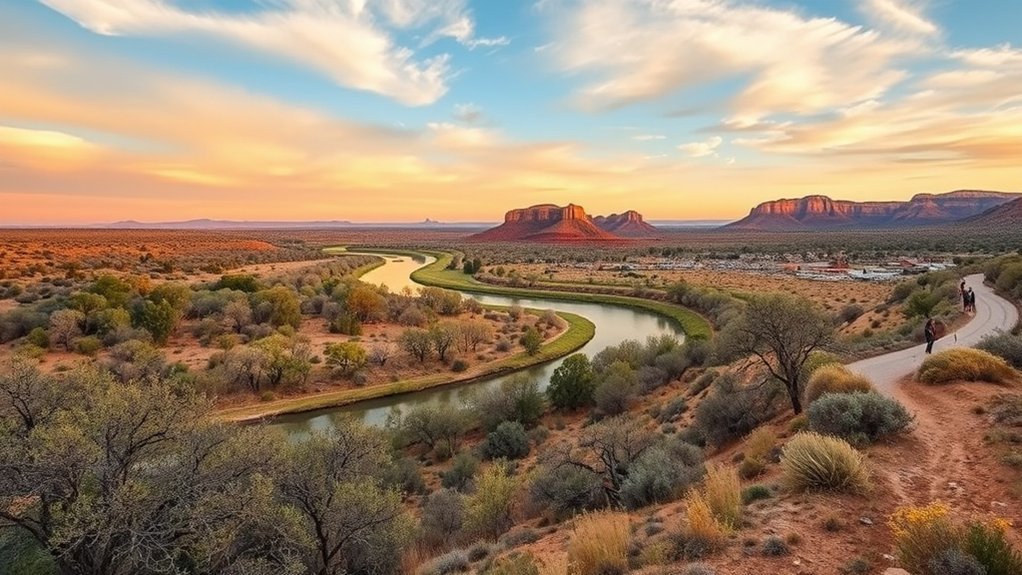
Dead Horse Ranch State Park sits on 423 acres along the Verde River near Cottonwood, Arizona, and offers a mix of riparian habitat, cottonwood-willow bosque, and lakes that attract birders, anglers, and hikers alike. You’ll find concise park history noted on signage and at the ranger station, explaining its transformation from private ranchland to a protected state park. Practical quick facts: hours, entrance fees, camping options, and seasonal water levels are posted online and updated by staff. For planning, use these visitor tips: book campsites early, pack layered clothing for desert temperature swings, bring binoculars and permit-required fishing gear, and follow Leave No Trace. Rangers enforce rules to protect wildlife and sensitive vegetation; obey posted restrictions.
Top Trails and Scenic Spots
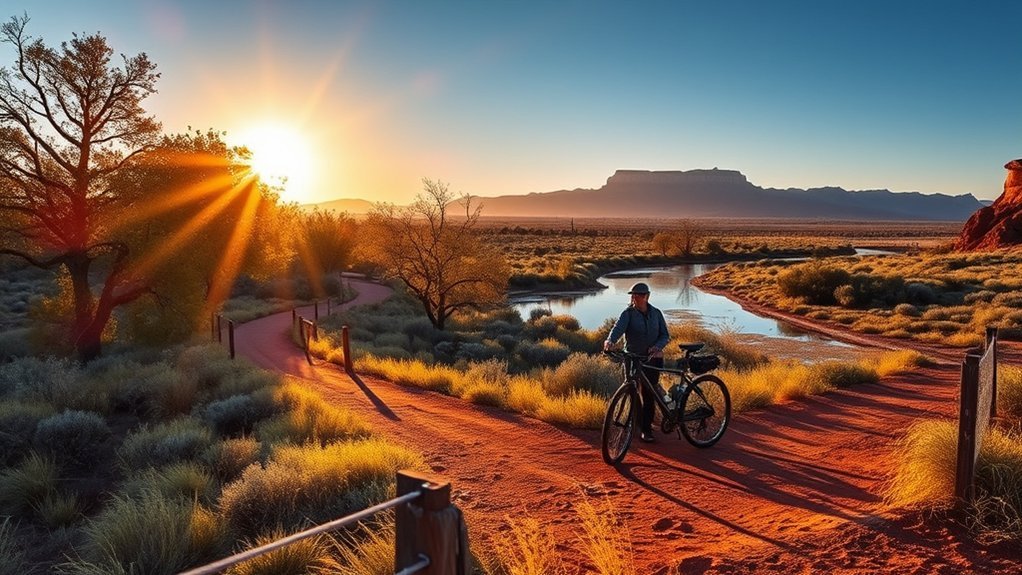
While you’re here, prioritize the Verde River Trail and the Lakeside Loop for a quick, rewarding introduction to the park’s habitats; both offer easy access, clear signage, and frequent wildlife sightings. After that, head to the Sycamore Trail and the Riverfront Boardwalk for varied terrain and dependable birdwatching. For best hiking that combines distance and views, try the multi-segment loop linking Cottonwood and Sycamore—expect riparian corridors, cottonwoods, and river access points. Stop at marked scenic viewpoints near the small cliffs above the river to photograph reflections and hawks on thermals. Trails are well-maintained; maps at trailheads show difficulty and distance. Stick to designated paths to protect fragile vegetation and to keep encounters with wildlife safe and predictable.
Camping, Day-Use Areas, and Amenities
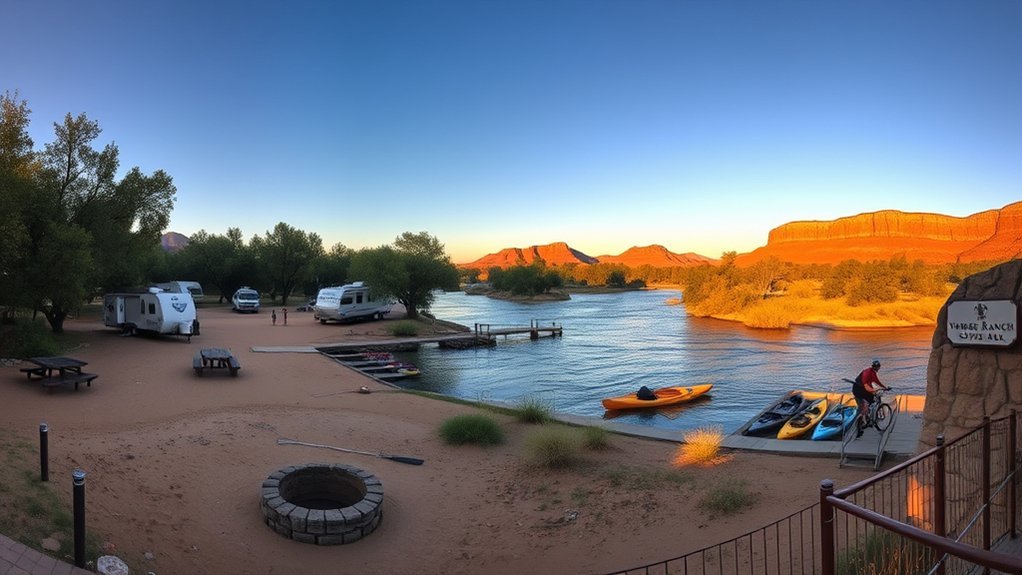
You’ll find a mix of tent and RV sites set among cottonwoods and along the Verde River, with options for both primitive camping and full-hookup spaces. Day-use areas and picnic sites are well-maintained and positioned for easy access to trails and river vistas. Restrooms, showers, and utility hookups are available to keep your stay comfortable and convenient.
Tent and RV Sites
At Dead Horse Ranch State Park you’ll find well-maintained tent sites and full-hookup RV spots set among cottonwoods and along the Verde River, offering easy access to trails, picnic areas, and boat ramps. You’ll choose between shaded tent camping pads near water or paved RV pads with reliable rv amenities; both have nearby restrooms and potable water. Reservations are recommended during peak season. Quiet hours and campsite limits protect the experience. Keep a short walk to trailheads and boat launches in mind when selecting a loop.
| Site Type | Typical Features | Best For |
|---|---|---|
| Tent Sites | Grassy pads, shade, fire rings | Lightweight campers |
| Full-hookup RV | 30/50A, sewer, water | Large RVs |
| Partial RV | Water/electric only | Mid-size rigs |
Picnic and Day Areas
Because picnic areas cluster near the river and trailheads, you can grab a shady table, launch a kayak, or stretch out on a lawn without wasting time walking between activities. You’ll find dispersed picnic spots designed for quick day activities or longer social gatherings. Tables, grills, and open lawns sit beside clear signage and paved access, so you’ll move efficiently from parking to pastime. Keep food secured from wildlife and follow park rules to protect the area.
- Choose a riverside table for lunch, then step onto a trailhead for a short hike.
- Reserve a sheltered spot for group gatherings and bring portable gear for games.
- Use open lawns for relaxation, sunbathing, or setting up a small picnic blanket.
Plan your day activities around site proximity and peak shade times.
Restrooms and Utility Hookups
After enjoying a riverside lunch or stretching out on the lawns, check the park’s restroom locations and utility hookups before settling in—knowing where facilities sit saves time and keeps your group comfortable. You’ll find clean restroom facilities near trailheads, picnic zones, and the campground. Seasonal hours and maintenance are posted; plan around rush times. If you’re camping, verify utility services—water, sewer, and 30/50A electric—at your reserved site. Staff can confirm hookup compatibility and offer alternatives if sites are full. Keep hoses and adapters handy, and follow posted dumping rules. For quick comparison of typical site features, refer to the table below.
| Area | Restroom Facilities | Utility Services |
|---|---|---|
| Campground | Vault & flush | Water, electric |
| Group site | Portable/flush | Limited water |
| Day-use | Flush | None |
| Trailhead | Vault | None |
| Fishing area | Vault | None |
Fishing, Wildlife Viewing, and Recreation
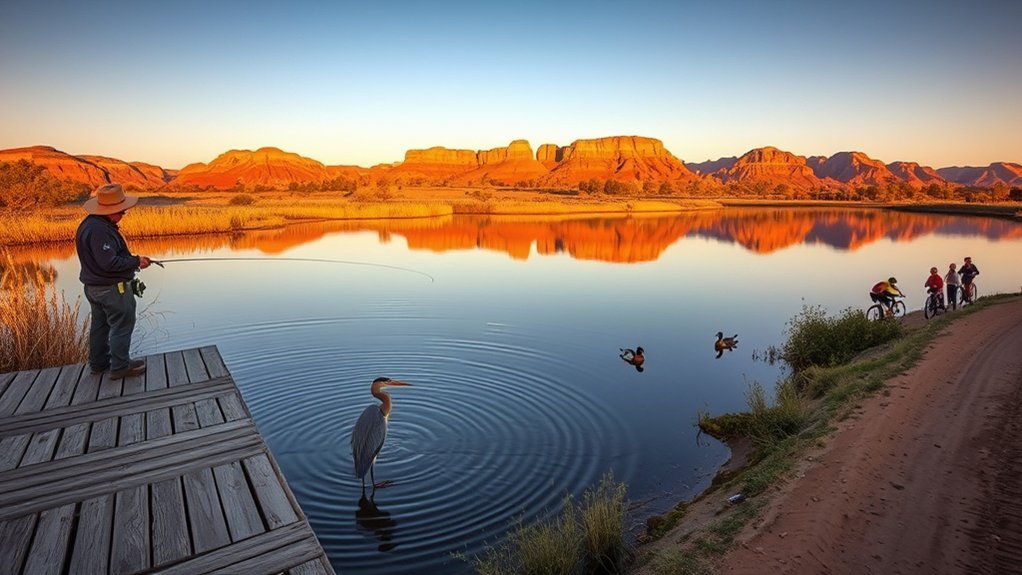
While you’re here, Dead Horse Ranch offers excellent opportunities for fishing, wildlife viewing, and outdoor recreation that suit beginners and experienced visitors alike. You’ll find well-maintained banks and stocked waters where applied fishing techniques — from fly casting to bait fishing — increase your success. Trails and quiet hides let you observe deer, herons, and raptors; bring gear for wildlife photography and practice ethical distance. Rangers and signage explain habitats and regulations, so you’ll stay safe and compliant.
- Rent kayaks or bring your own for river access to reach prime fishing spots and birding vantage points.
- Use the multi-use trails for hiking, biking, and interpretive nature walks to learn species identification.
- Join guided programs or self-guided observation for targeted, responsible wildlife encounters.
Best Times to Visit and Weather Tips
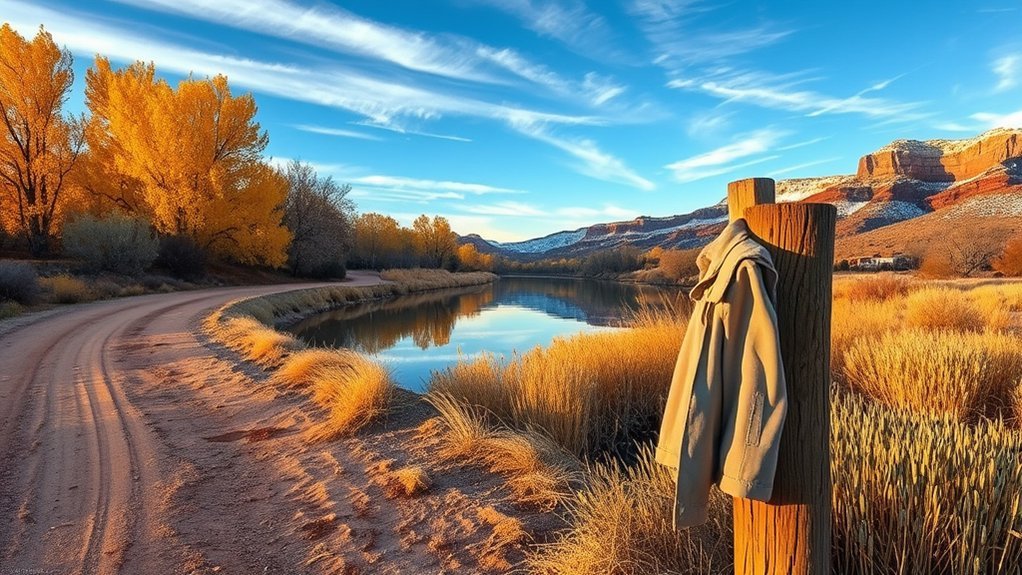
Plan your visit for spring and fall when the park’s temperatures are mild and crowds are smaller. Check daily forecasts and pack layered clothing, sun protection, and rain gear so you can adapt to sudden changes. If you’re coming in summer or winter, prepare for heat or cold extremes and adjust activities and hydration accordingly.
Peak Season Timing
If you want milder weather and full amenities, aim for spring (March–May) and fall (late September–November), when daytime temperatures sit comfortably in the 60s–80s°F and crowds are moderate. During these peak season periods you’ll find peak season activities fully staffed and scheduled; visitor crowd patterns lean toward day-trippers on weekends and steady campers midweek. You’ll enjoy trail access, boat rentals, and interpretive programs without the summer heat.
- Plan weekday visits for quieter trails and better campsite selection.
- Reserve popular services early for weekends and holiday periods.
- Expect increased parking and busier picnic areas on sunny weekends.
Knowing timing and typical visitor crowd patterns lets you match your itinerary to quieter or livelier days.
Weather Preparation Tips
Because weather can change quickly at Dead Horse Ranch, check forecasts and pack layers so you’re ready for cool mornings, warm afternoons, and chilly evenings. Plan visits in spring or fall for mild conditions and lower crowds; summer brings high temps and intense sun, while winter can be cold and windy. Expect temperature fluctuations between day and night—bring thermal base layers, a windproof jacket, and breathable shirts. Prioritize sun protection: wide-brim hat, UV-blocking sunglasses, broad-spectrum sunscreen, and lightweight long sleeves for mid-day exposure. Carry extra water and schedule strenuous activities for mornings. Secure a weatherproof map, charged phone, and a small first-aid kit. Monitor local alerts, adjust plans for storms or extreme heat, and know exit routes for a safe, comfortable visit.
Nearby Attractions and Practical Travel Tips
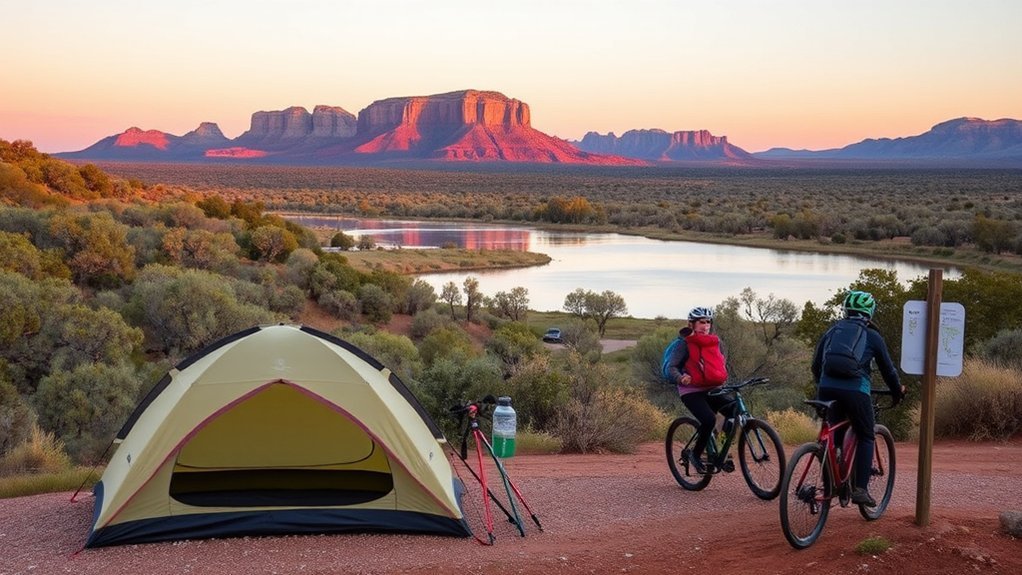
Road for scenic rides through the canyon. You’ll find nearby Sedona and Cottonwood offer quick side trips that enrich your stay. Plan stops for local dining and shopping options in Old Town Cottonwood, then return to trails or the Verde River. Pack layers, sunscreen, and a refillable water bottle; cell service can be spotty, so download maps and park brochures ahead of time.
- Rent kayaks or tubes in nearby towns to extend river fun.
- Check seasonal festival schedules and farmers’ markets for fresh food and crafts.
- Use designated parking and follow trail etiquette to preserve habitats.
You’ll save time and avoid surprises by booking lodging and rentals in advance and keeping an eye on park alerts.
Frequently Asked Questions
Are Pets Allowed in All Park Areas and Trails?
No, you can’t bring pets into all areas; park pet policies require leashes and restrict pets from certain trails, wildlife areas, and buildings. You’ll find designated pet friendly areas and must follow posted rules to avoid fines.
Are There Guided Tours or Ranger Programs Available?
Absolutely — you’ll find guided nature walks and educational programs led by rangers; they’ll deepen your experience like a clear map, and you’ll get schedules, safety tips, and interpretive talks to enrich hikes and wildlife viewing.
Is Cell Phone Reception Reliable Within the Park?
Reception’s patchy; you won’t always have reliable cell service or consistent network coverage throughout the park. Expect better signals near park entrances and nearby towns, but plan for limited connectivity while hiking or camping in remote areas.
Are There Ada-Accessible Restrooms and Trails?
Yes — you’ll find ADA facilities and accessible restrooms, and some Trail accessibility features like paved segments and boardwalks. You’ll encounter accessible parking, ramps, and signage; contact park staff for specific route details and assistance.
Can Drones Be Flown Over Park Lands?
“Better safe than sorry.” You can’t fly drones over park lands; state and federal drone regulations impose flying restrictions to protect wildlife and visitors. You’ll need permits and must follow posted rules and no-fly zones.
Conclusion
You’ll leave Dead Horse Ranch State Park refreshed and ready for more adventures. With its riverside cottonwoods, varied trails, and high-quality fishing, it’s a birdwatcher’s—and angler’s—dream come true. Campsites and day-use areas are well maintained, and nearby towns offer dining and extras. Visit in spring or fall, pack layers and water, and respect wildlife. Follow park rules, plan ahead, and you’ll experience scenery so vivid it feels like nature turned up the color dial.

